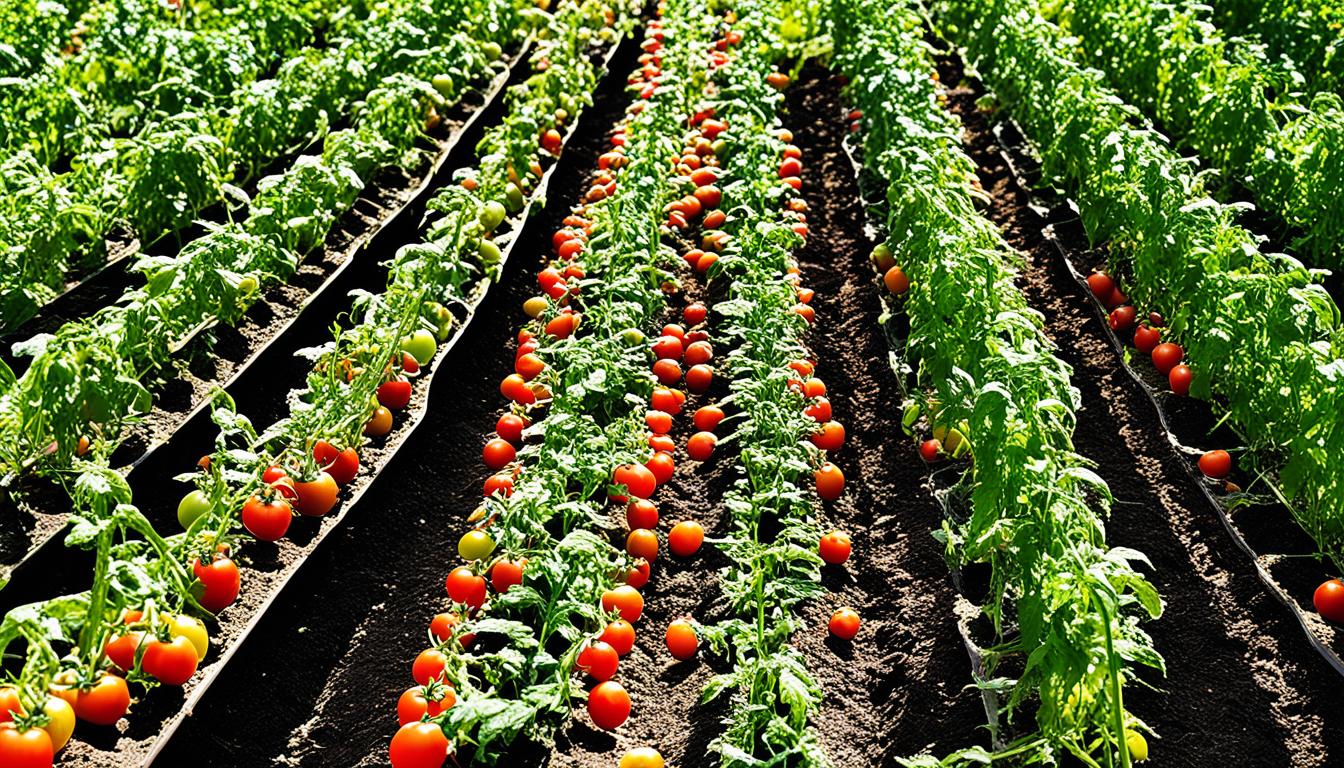In 2022, sales of organic tomatoes hit $267.3 million, making up 6.7% of all tomato sales.
Although sales dropped by 3.2% to 67.8 million pounds, it’s still a big part of the market.
It shows how important these tomatoes are to consumers.
The number of people who only buy organic tomatoes rose to 15% in 2024, from 14% the year before. And, 37% of people sometimes choose to buy organic fresh tomatoes, more than the 34% from the previous year.
Key Takeaways
- Organic tomato retail sales reached $267.3 million in 2022, accounting for 6.7% of the total retail tomato market.
- 15% of consumers reported purchasing organic tomatoes exclusively in 2024, up from 14% the previous year.
- 37% of consumers bought organic fresh tomatoes at least some of the time in 2024, up from 34% in the prior year.
- Consumers with an annual income over $100,000 were more likely to exclusively purchase organic tomatoes, with 17% doing so.
- Younger consumers, particularly those aged 18–29, were the most likely to buy organic tomatoes exclusively.
Introduction to the Tomato Puree Market
Tomato puree is a key ingredient in many dishes worldwide. It is especially loved in Italian food and quick, healthy meals.
The popularity of this sauce has soared recently. This is due to more people wanting convenient, health-friendly foods.
What is Tomato Puree?
Tomato puree is a rich, thick sauce made by cooking and straining tomatoes.
Its smooth texture and intense flavor make it perfect for soups, sauces, and more. This process removes the skins and seeds, leaving a delicious paste behind.
Key Applications and Uses
Tomato puree is found in many dishes, like pizza, pasta, and lasagna. It’s also used in canned foods and ready-to-eat meals. In the food service industry, chefs use it to improve the taste and feel of their creations.
Not just tasty, tomato puree is also good for health. It’s full of lycopene, an antioxidant linked to multiple health benefits.
More people are choosing organic and non-GMO options for their health and the planet.
| Tomato Puree Market Trends | Key Insights |
|---|---|
| Market Size and Growth | The global tomato puree market was valued at $5.2 billion in 2022 and is estimated to reach $7.7 billion by 2032, with a CAGR of 4.1% from 2023 to 2032. |
| Segmentation by Nature | In 2022, the conventional segment dominated the tomato puree market, but the organic segment presents significant growth opportunities due to rising consumer demand for healthier and more diverse food options. |
| Segmentation by Packaging | Tin packaging was the leading choice for tomato puree in 2022 and is expected to continue dominating the market, while the glass jar segment is anticipated to be the fastest-growing packaging option. |
| Segmentation by Application | The food and beverage industry segment led the tomato puree market in 2022 and is expected to maintain dominance, reflecting the versatile application of tomato puree in various culinary dishes. |
| Segmentation by Distribution Channel | The B2B distribution channel was prominent in the tomato puree market in 2022, but the retail channels, such as supermarkets/hypermarkets, convenience stores, and online sales, are also expected to grow significantly. |
The increase in demand for processed food has been a significant driver for the growth of the tomato puree industry.
The market for tomato puree is growing fast. It’s fueled by the love for Italian food, the need for quick meals, and health awareness.
As people look for diverse and eco-friendly food choices, the market for organic and non-GMO tomato puree is also expected to expand.
Market Segmentation: Organic vs. Conventional Tomatoes
The tomato puree market has two main groups: organic and conventional. Organic tomato puree comes from farms that don’t use fake chemicals.
It’s better for people who care about the environment and their health. Conventional tomato puree is made in a more traditional way. This often means using chemicals.
Organic Tomato Puree
More and more people are choosing organic tomato puree. They like that it’s good for their health and the planet.
These folks don’t mind paying extra for products made without synthetic stuff.
They also prefer organic foods because they are made in ways that don’t hurt the earth. The market for organic tomato puree keeps growing as people look for natural and green food choices.
Conventional Tomato Puree
Conventional tomato puree is less costly, which appeals to some shoppers. In the US and China, many people buy this type. The US has a big system for selling it.
China’s market is growing because people are cooking more Western meals. Even though it isn’t as good for the environment or your health as organic, it is a budget-friendly option for many.
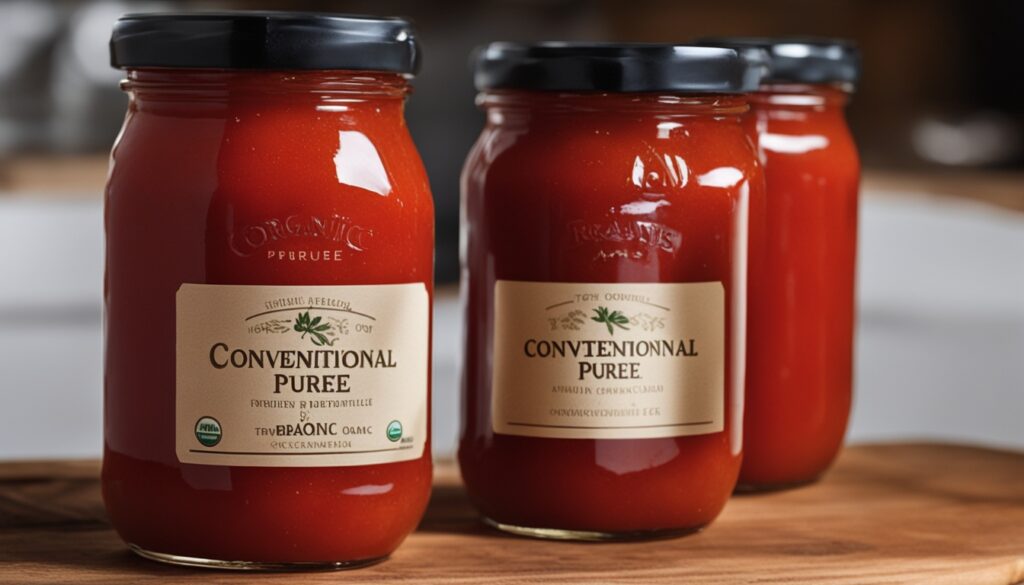
“The tomato puree market is segmented into two main types: organic and conventional. This segmentation caters to different consumer preferences, with organic tomato puree appealing to health-conscious and environmentally conscious consumers, while conventional tomato puree provides a more affordable option for some consumers.”
Many things affect the tomato puree market. What people want and how much they want to spend are a big deal.
Also, the prices of the ingredients can change, and there’s always competition from other foods. With more people in the world and new food trends, the market will keep changing.
Global Tomato Puree Market Trends and Growth
The global tomato processing market is set to grow steadily. Between 2024 and 2032, it’s expected to increase by over 4.9% yearly. This growth is due to more people wanting easy-to-make foods, realizing the health benefits of tomatoes, and the love for Italian dishes.
The tomato puree market will see a 4.0% annual growth from 2024 to 2030. By 2030, it should be worth USD 6,032 million. People are choosing premium, healthy tomato purees, including organic options, driving this demand.
Companies are working hard to innovate and offer new tomato puree products. They are adding to their ranges and improving their products based on what consumers want, like organic and natural options.
Also, the demand for packaged foods that are good for health has gone up by 46% from 2019 to 2022. This is pushing the market for healthy, tomato-based products.
Even with challenges in tomato supply and price changes, the tomato derivatives market will keep growing.
Over the next few years, it will increase by 10.5%. This growth is supported by new technology and better ways to process, pack, and analyze data in the industry.
The tomato puree market is always changing. Trends like caring for the environment, new cooking styles, and plant-based options will influence its path. Companies need to be quick and smart about these changes to do well in this lively market.
Regional Analysis of the Tomato Puree Market
The global tomato puree market has different markets worldwide. Each place has its unique market flow and chances to grow. North America and Europe lead in tomato puree consumption. This is because people here love products made from tomatoes.
In the Asia-Pacific, countries like China and India have started to use more tomato puree. This is because people are learning about the good things that tomatoes can do for health. And, they are also enjoying the taste of Western food more.
Latin America and the Middle East & Africa are seeing more chances for their markets too. Here, local companies are making purees that reflect their own traditional tastes.
North America
North America is very important for the tomato puree market. The United States and Canada are big on using tomato puree. People in these countries really like Italian and Mexican foods, boosting the demand for tomato puree. The market here benefits from a strong network for getting products to people. Also, people like to eat foods that are easy to prepare.
Europe
Europe’s market for tomato puree is already well developed and has strong competition.
Countries like Germany, France, the U.K., Italy, and Russia especially like to use tomato puree in their foods.
The region’s deep food traditions have played a big part in this. But, there are many small and local companies here. This can make it hard for big brands to stand out.
Asia-Pacific
In the Asia-Pacific, countries such as China and India are key markets for tomato puree. The region’s growing population and changing lifestyles are boosting the use of tomato puree. People here are also adding tomato puree to their traditional dishes, helping the market grow even more.
Latin America
Latin America loves its tomato puree, especially in countries like Mexico and Brazil. Here, people like different types of tomato puree, leading to a varied market. As the number of people in the middle class grows, so will the demand for quality tomato puree.
Middle East & Africa
The Middle East & Africa are also warming up to tomato puree, with places like Turkey and the UAE showing interest.
The demand for easy-to-prepare foods and the love of Western eating habits is driving the market here. Even with this growth, however, there is still a lot of room for the market to develop, giving both local and international brands a chance to shine.
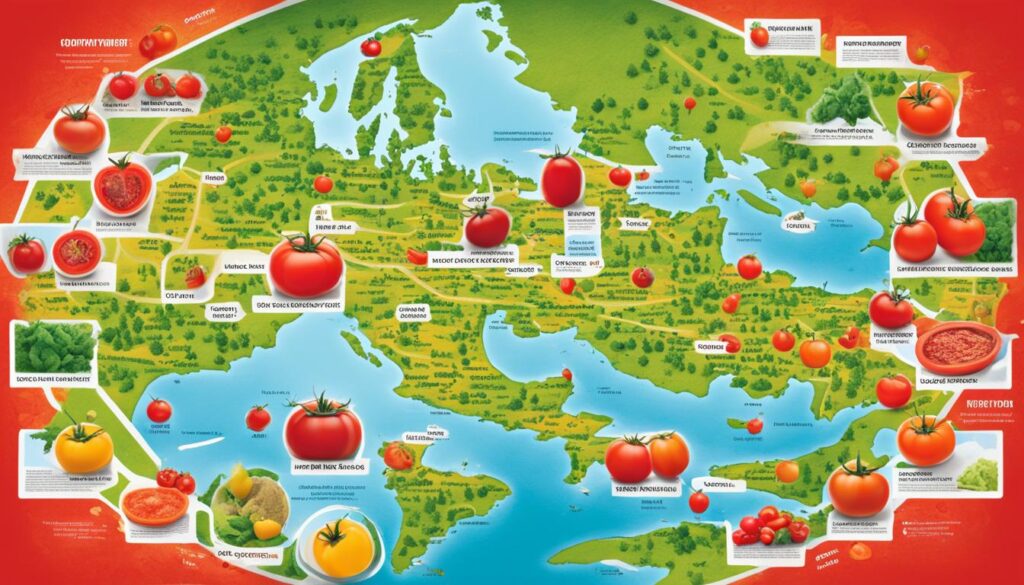
In closing, the tomato puree market is spread out globally. Each area has its own charm and chances to grow.
While North America and Europe lead, the future looks bright for the Asia-Pacific, Latin America, and Middle East & Africa regions. Here, as people’s tastes change and their incomes rise, the demand for tomato puree and similar products will also go up.
Consumer Preferences and Purchasing Patterns
Organic Purchasing Patterns and Demographics
The Packer’s Organic Fresh Trends 2024 survey found interesting facts about how people buy organic tomatoes.
Fifteen percent of shoppers only bought organic tomatoes, up from last year’s 14%.
Those with a higher income, over $100,000 a year, preferred organic tomatoes more. Seventeen percent of them bought only organic tomatoes, while this was true for only 13% of those earning under $25,000.
Families with kids were also likely to choose organic tomatoes. Twenty-six percent of families with one child, 21% with two, and 19% with three or more children did so.
The Northeast led in exclusive organic tomato purchases at 19%. Meanwhile, the Midwest had the lowest rate at 11%. Young adults aged 18-29 were the top buyers, with 30% choosing only organic tomatoes. This figure was much lower, at 2%, for those 60 and older.
These findings show that income, family size, location, and age impact organic buying choices. Knowing these trends helps companies focus on organic shoppers more effectively.
“Organic products were sold in 73% of all conventional grocery stores in the United States.”
Organic items are now common in regular stores, boosting their sales. As they’re more available, people of all ages and incomes can buy them. This change is making organic foods a part of more shopping lists.
The organic food sector has grown a lot in the last years. Yet, businesses must still understand what consumers want to sell more organic products.
By focusing on what customers like and need, brands can do well in the changing market for organic items.
Organic vs. Conventional Tomatoes: Market Trends
Organic tomatoes keep their high price, drawing buyers looking for health and eco-benefits. Yet, in 2022, their sales slipped by 1.5%, with 3.2% less sold. Still, they make up a big part of tomato sales at 6.7%.
People worry about food safety and farming’s effects on the earth, boosting the demand for organic options.
Organic tomatoes are better for you, rich in lycopene, vitamin C, and antioxidants, compared to non-organic ones. Organic farming makes certain types of tomatoes taste better, too.
Though a few studies find no big nutrient differences in organic and non-organic tomatoes, more people still prefer organic for its health and eco benefits. The organic tomato market is always changing. To keep up, makers will need to follow what consumers want.
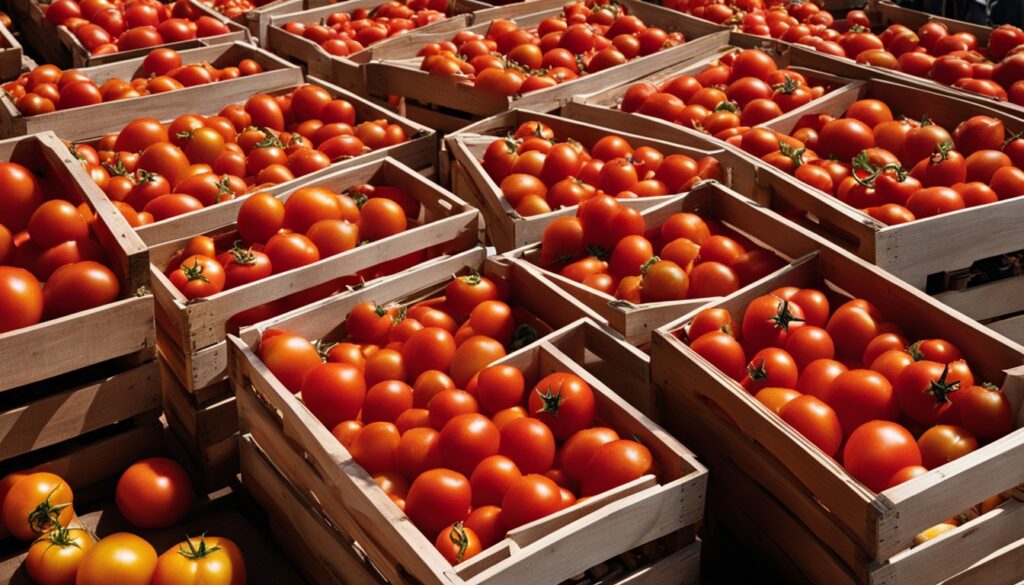
“Organic agriculture has been increasing in demand due to consumers willing to pay more for food produced without pesticide residues.”
By 2024 to 2031, demand for Organic Tomato Paste will grow by 6.3% each year. Right now, canned organic paste is top because it’s easy to find and use. But bagged paste is doing well, too, as people care more about less waste and earth-friendly products.
Big names in the organic paste world are Morning Star, Pacific Coast Producers, and Muir Glen, pulling in a lot of sales. The organic paste market should grow at a rate of 6-8% each year.
The organic tomato market is always changing. So, companies and growers must adjust to what customers want: healthy, green, and top-quality tomatoes. Knowing the latest market trends and consumer needs can help them succeed in a fast-growing business.
Key Players in the Tomato Puree Industry
Several key players lead the tomato puree market. They are known for their top-quality products, new ideas, and large networks. Companies like Symrise, Dohler, Kiril Mischeff, Riviana Foods, and many others stand out.
These leaders meet the increasing need for tomato puree. Its use in the food and drink world is growing. In 2022, the market was worth $5,189.9 million. It’s expected to hit $7,699.5 million by 2032. This growth shows a yearly increase of 4.1%.
Symrise and Dohler are known for their eco-friendly ways. This has pleased customers who care about the environment. Riviana Foods, part of Ebro Foods, operates in North America, Europe, and Asia. It uses its big global network to reach many customers.
These companies’ wide product range and networks help the market grow. With more people wanting tomato-based products, these top players are ready. They aim to lead the way and keep their spots at the front of the industry.
Drivers, Restraints, and Opportunities
The global tomato puree market is booming thanks to people wanting more convenient and healthy food choices.
Also, more folks are learning about the health perks of tomato goodies. In the food and drink world, tomato puree is becoming quite the star.
It’s valued at USD 195.34 billion now. Experts think it will grow to USD 294.06 billion by 2032. That’s a 4.65% growth every year from 2024 to 2032.
In the world, Asia-Pacific leads in selling tomatoes. It’s growing fast, at a rate of 5.36%. However, North America’s sales are speeding up even more. They’re expected to grow by 4.89% a year over the same time.
Market Drivers
More people want easy and healthy foods. This is great news for the tomato puree market. Last year, the global tomato industry was worth USD 194.52 billion. Now, it’s set to grow to about USD 300.84 billion by, with a growth rate of 4.9% every year.
People really like products made with organic, natural, and balanced tomatoes. This is boosting the need for tomato puree and other products made from tomatoes. Also, the use of tomato puree in many foods and drinks, like sauces and soups, is helping the market grow.
Market Restraints
Despite its success, the tomato puree market does face some challenges. For example, the cost of making tomato puree can change often.
There’s also the risk that customers might pick other tomato products over puree. These challenges are real. They show up as pests and diseases on tomato plants.
This can lower how many tomatoes are grown, make it cost more to produce them, and even cause financial losses. Bad weather and climate change bring even more.
They can harm tomato plants directly, through heat or extreme weather, or affect the bugs that may hurt them. All this can shake up tomato prices, which is tough for the people making them.
Market Opportunities
Even with challenges, there are ways for the tomato puree market to grow. Some companies are exploring making puree that’s 100% organic and natural, using green-hued production methods, and finding new ways to get their products out there.
People are really into healthy and natural foods. This is a big chance for the worldwide tomato market. It meets what many people want: products filled with nutrients, fresh, and not too processed.
New technology is also making a difference. For example, using advanced farming methods with AI can cut down on the use of harmful chemicals by 20%.
It can also make tomato plants produce more by 30%. These moves can help the tomato puree market expand and become more competitive. Experts think it will grow by 11% each year until 2026, reaching a big market size.
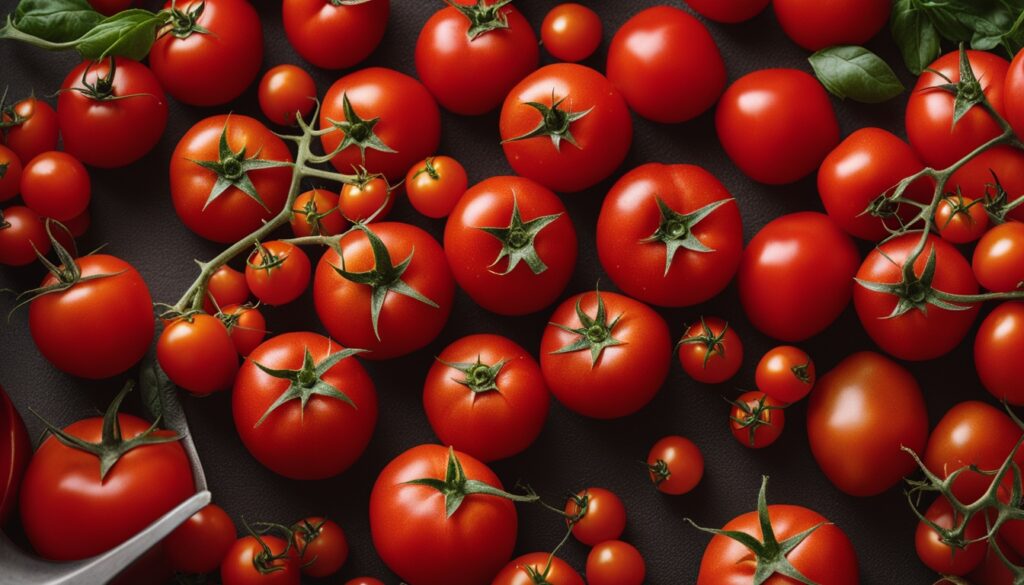
“The global tomato puree market is poised for significant growth. This comes from more people wanting healthy, easy foods and from new uses for tomato puree in foods and drinks.”
Future Outlook and Growth Prospects
The future looks bright for the tomato puree market. Experts predict steady growth. It’s all thanks to people wanting food that is easy and healthy. The market is set to grow by 11% each year from 2024 to 2026. This will make it reach $XXX billion by 2026.
New tomato puree types, like organic and all-natural, will boost the market. Plus, folks loving dishes with tomatoes will help too.
Cities are growing bigger and people have more money to spend. This, along with knowing how good tomatoes are for us, will push the market ahead.
The global market for tomatoes is set to grow, expecting to hit 63.3 million tons by 2032. Most of this will be through sauces. And most people will buy them from stores.
In North America, the tomato market will be worth USD 28,831.01 million by 2030. The growth is because more tomatoes are being used in foods like juice, ketchup, and sauces.
Challenges like changing tomato prices and the environment exist. But, the market still has a lot of room to grow. Using artificial intelligence can improve tomato farming. This is a big chance for the market.
“The future of the tomato puree market is undoubtedly bright, as consumers continue to seek out convenient, healthy, and innovative food options.”
Conclusion
The market for organic vs. conventional tomatoes is always changing. People are liking sustainable farming more. Despite the higher price, organic tomatoes’ sales dropped by 1.5% in 2022. Still, they make up 6.7% of all tomato sales.
The tomato puree market is set to grow. This growth is because people want easy, healthy food, love Italian dishes, and care about the earth.
Big players in the business are getting ready for these changes. They are offering organic and non-organic tomato puree to meet everyone’s needs.
Research shows organic tomatoes have more antioxidants and less harmful stuff than non-organic ones. Also, making organic tomatoes tends to be better for the planet.
The push for clear, green, and healthy products will bring new ideas in the tomato puree market. People are becoming more informed about how their choices affect the planet and their health.
This new knowledge will guide the tomato puree market’s future. It’s a chance for companies to match the market’s new demands.
FAQ
What are the key market trends for organic vs. conventional tomatoes?
A report by The Packer tells us about tomato sales. In 2022, organic tomato sales fell by 1.5% to 7.3 million. This drop included a 3.2% decrease in organic tomato volume.
But, organic tomatoes still made up a big 6.7% of all tomato sales. The report also found that 15% of people only buy organic tomatoes. This number went up from the year before.
And 37% of people buy some organic fresh tomatoes. This also increased from the previous year.
What is tomato puree and what are its key applications?
Tomato puree is a thick sauce made from cooked and strained tomatoes.
It is widely used in many dishes to enhance their taste. According to Validus Research, the market for tomato puree will grow by 11%. This is from 2024 to 2031.
The rising demand for easy-to-cook food and the health benefits of tomatoes are the reasons. It’s also because of the love for Italian food worldwide. Tomato puree is used in many ways, including in cooking, baking, and making various sauces.
How is the tomato puree market segmented?
The tomato puree market is split into organic and conventional. Organic tomato puree is grown with natural methods, avoiding chemicals. This means it’s better for the earth and people who care about their health.
Conventional tomato puree uses traditional farming with chemical pesticides. It offers an affordable option. So, people who look out for their health or the environment choose the organic one. Others might choose the conventional for its price.
What are the key regional trends in the global tomato puree market?
The tomato puree market looks different in each part of the world. Major regions include North America, Europe, Asia-Pacific, Latin America, and the Middle East & Africa. North America and Europe consume a lot of tomato puree because they love its taste.
In Asia-Pacific, places like China, India, and Japan are starting to use more tomato puree.
This is because people there are learning about its health benefits. Latin America and the Middle East & Africa are also growing markets. Here, local brands offer traditional tomato puree, which is very popular.
What are the consumer preferences and purchasing patterns for organic tomatoes?
In the year 2024, 15% of people always chose organic tomatoes when shopping.
This was more than the year before. Richer families, those making over 0,000 a year, bought organic tomatoes the most.
Families with kids also preferred organic. Especially those with one child. Different areas had different rates of organic tomato shopping. Young adults, those aged 18-29, bought the most organic tomatoes.
Who are the key players in the tomato puree industry?
The tomato puree sector has many big participants. Some include Symrise, Dohler, and Kiril Mischeff. Others are Riviana Foods and Tiger Brands. You’ll also find Del Monte Foods and H.J. Heinz in this field.
These companies lead with top-quality items, new ideas, and large distribution networks.
What are the key drivers, restraints, and opportunities in the tomato puree market?
The global tomato puree market is growing for several reasons. People want food that’s both easy and good for them. They are learning about the health benefits of tomato products.
However, the market faces challenges like changing raw material prices. It must also deal with the competition of other products.
To win against these challenges, companies are making more organic and natural tomato puree. They also focus on making their production and sourcing practices sustainable.
What is the future outlook for the tomato puree market?
The future looks bright for the tomato puree market. Demand is increasing for simple, healthy food options. This includes the desire for organic and all-natural tomato puree.
And as more people discover and enjoy cuisines with tomato-based recipes, the market will continue to grow. It’s projected to increase by 11% each year until 2026. At that time, it’s estimated to be worth over $ billion.
Source Links
- https://www.producemarketguide.com/news/heres-how-organic-tomato-purchases-are-trending-according-consumer-survey
- https://www.einpresswire.com/article/704019849/tomato-puree-market-size-projected-to-reach-7-7-billion-by-2032-with-cagr-of-4-1
- https://www.alliedmarketresearch.com/tomato-puree-market-A11031
- https://www.databridgemarketresearch.com/reports/global-tomato-pastes-and-pures-market
- https://www.linkedin.com/pulse/tomato-puree-market-insight-trends-growth-forecasted-from-2024-muomf
- https://www.linkedin.com/pulse/tomatoes-market-analysis-report-2033-size-trends-outlook-rhfaf
- https://www.databridgemarketresearch.com/reports/global-tomatoes-market
- https://www.gminsights.com/industry-analysis/tomato-processing-market
- https://www.verifiedmarketreports.com/product/tomato-puree-market/
- https://www.tomatonews.com/en/latest-trends-in-the-global-market-for-tomato-products_2_2166.html
- https://www.linkedin.com/pulse/tomato-puree-market-growth-outlook-from-2024-2031-projecting-npe2c
- https://www.ncbi.nlm.nih.gov/pmc/articles/PMC8992384/
- https://www.ers.usda.gov/webdocs/publications/42455/13377_aib777c_1_.pdf?v=0
- https://www.ncbi.nlm.nih.gov/pmc/articles/PMC7019963/
- https://journalajaees.com/index.php/AJAEES/article/view/2397
- https://core.ac.uk/download/pdf/47140068.pdf
- https://www.linkedin.com/pulse/strategic-insights-global-organic-tomato-paste-market-we6ve
- https://www.linkedin.com/pulse/tomato-puree-market-size-share-growth-research-ob4tf
- https://www.prnewswire.com/news-releases/tomato-puree-market-to-reach-7-699-5-million-globally-by-2032-at-4-1-cagr-allied-market-research-302089000.html
- https://straitsresearch.com/report/tomato-market
- https://www.econmarketresearch.com/industry-report/tomatoes-market/
- https://www.mordorintelligence.com/industry-reports/tomato-market
- https://www.imarcgroup.com/tomato-processing-plant
- https://www.databridgemarketresearch.com/reports/north-america-tomatoes-market
- https://www.intechopen.com/chapters/46456
- https://www.ncbi.nlm.nih.gov/pmc/articles/PMC10963740/
- https://www.ncbi.nlm.nih.gov/pmc/articles/PMC5224547/
